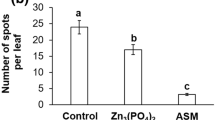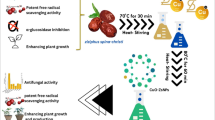Abstract
This study was conducted to evaluate the ability of zinc oxide nanoparticles (ZONPs) with unique properties to protect tomato against the bacterial speck pathogen, caused by Pseudomonas syringae pv. tomato DC3000 (Pst). Protection of tomato against bacterial speck using ZONPS was evaluated by its direct antibacterial activity and its ability for inducing resistance in tomato plants. The results revealed that ZONPs showed significant direct antibacterial activity against Pseudomonas syringae pv. tomato under laboratory conditions. Moreover, tomato plants treated with ZONPs showed a significant reduction in disease severity and bacterial proliferation relative to non-treated plants. Furthermore, tomato plants treated with ZONPs showed higher self-defense enzyme activity relative to untreated plants. The regulatory and defense genes, LePR-1a and Lipoxygenase (LOX), involved in the salicylic acid (SA) and (JA) signaling pathways, respectively, were highly expressed in tomato plants treated with ZONPs compared to untreated plants. Growth characters of tomato plants treated with ZONPs were significantly enhanced relative to untreated plants. The control of bacterial speck pathogen of tomato using ZONPs through its direct antibacterial and by developing of systemic resistance in treated tomatoes against the pathogen is considered the first report.








Similar content being viewed by others
References
Aime S, Alabouvette C, Steinberg C, Olivain A (2013) The endophytic strain Fo47: a good candidate for priming the defense response in tomato roots. Mol Plant Microbiol Interact 26:918–926. https://doi.org/10.1094/MPMI-12-12-0290-R
Akhtar MJ, Kumar AM, Khan MM, Ahmad J, Alrokayan SA (2012) Zinc oxide nanoparticles selectively induce apoptosis in human cancer cells through reactive oxygen species. Inter J of Nanomed 7:845–857. https://doi.org/10.2147/IJN.S29129 Epub 2012 Feb 21
Aruoja V, Dubourguier H, Kasamets C, Kahru KA (2009) Toxicity of nanoparticles of CuO, ZnO and TiO2 to microalgae, Pseudokirchneriella subcapitata. Sci Total Environ 407:1461–1468. https://doi.org/10.1016/j.scitotenv.2008.10.053
Barik TK, Sahu B, Swain V (2008) Nanosilica-from medicine to pest control. Parasitol Res 103:253–258. https://doi.org/10.1007/s00436-008-0975-7
Batsmanova LM, Gonchar LM, Taran NY, Okanenko AA (2013) Using a colloidal solution of metal nanoparticles as micronutrient fertilizer for cereals, Proceedings of the International Conference Nanomaterials, 2, no. 4, 2 pages.
Bradley EL, Castle L, Chaudhry Q (2011) Applications of nanomaterials in food packaging with a consideration of opportunities for developing countries. Trends Food Sci Technol 22(11):604–610. https://doi.org/10.1016/j.tifs.2011.01.002
Bryan MK (1933) Bacterial speck of tomatoes. Phytopathol 23:897–904
Chaudhry Q, Scotter M, Blackburn J, Ross B, Boxall A, Castle L, Aitken R, Watkins R (2008) Applications and implications of nanotechnologies for the food sector. Food Addit & Cont Part A 25(3):241–258. https://doi.org/10.1016/j.tifs.2011.01.002
Cioffi N, Torsi L, Ditaranto N, Tantillo G, Ghibelli L, Sabbatini L, Bleve-Zacheo T, D'Alessio M, Zambonin PG, Traversa E (2005) Copper nanoparticle/polymer composites with antifungal and bacteriostatic properties. Chem Mater 17(21):5255–5262. https://doi.org/10.1021/cm0505244
Dietz KJ, Herth S (2011) Plant nanotoxicology. Trends Plant Sci 16: 582-589. doi.org/10.1016/j.tplants.2011.08.003.
Dimkpa CO, McLean JE, Britt DW, Anderson AJ (2013) Antifungal activity of ZnO nanoparticles and their interactive effect with a biocontrol bacterium on growth antagonism of the plant pathogen Fusarium graminearum. BioMet 26:913–924. https://doi.org/10.1007/s10534-013-9667-6
Divyapriya S, Sowmia C, Sasikala S (2014) Synthesis of zinc oxide nanoparticles and antimicrobial activity of murraya koeiniggi. World J of Pharm and Phram Sci 3: 12. In: 1 1635 -1645
Eichert T, Kurtz A, Steiner U, Goldbach HE (2008) Size exclusion limits and lateral heterogeneity of the stomatal foliar uptake pathway for aqueous solutes and water suspended nanoparticles. Physiol Plant 134:151–160. https://doi.org/10.1111/j.1399-3054.2008.01135.x
Elizabath A, Bahadur V, Misra P, Prasad VM, Thomas T (2017) Effect of different concentrations of iron oxide and zinc oxide nanoparticles on growth and yield of carrot (Daucus carota L.). J of Pharm and. Phytochem 6(4):1266–1269
Elsharkawy MM, Mousa KM (2015) Induction of systemic resistance against Papaya ring spot virus (PRSV) and its vector Myzus persicae by Penicillium simplicissimum GP17-2 and silica (Sio2) nanopowder. Int J Pest Manag 61: 353- 358. doi.org/10.1080/09670874.2015.1070930
Elsharkawy MM, Shimizu M, Takahashi H, Hyakumachi M (2012) Induction of systemic resistance against Cucumber mosaic virus by Penicillium simplicissimum GP17-2 in Arabidopsis and tobacco. Plant Pathol 61: 964-976. doi.org/10.1111/j.1365-3059.2011.02573.x.
Huang L, Dian-Qing L, Yan-Jun W, Min David G, Xueb ED (2005) Controllable preparation of Nano-MgO and investigation of its bactericidal properties. J Inorganic. Biochem 99:986–993. https://doi.org/10.1016/j.jinorgbio.2004.12.022
Idrees M, Naeem N, Aftab T, Khan MM, Moinuddin A (2011) Salicylic acid mitigates salinity stress by improving antioxidant defense system and enhances vincristine and vinblastine alkaloids production in periwinkle. Acta Physiol Plant 33:987–999. https://doi.org/10.1007/s11738-010-0631-6
Ippolito A, El Ghaouth A, Wilson CL, Wisniewski M (2000) Control of postharvest decay of apple fruit by Aureobasidium pullulans and induction of defense responses. Postharvest Biol Technol 19:265–272. https://doi.org/10.1016/S0925-5214(00)00104-6
Ibupoto ZH, Khun K, Eriksson M, AlSalhi M, Atif M, Ansari A, Willander M (2013) Hydrothermal growth of vertically aligned ZnO nanorods using a biocomposite seed layer of ZnO nanoparticles. Mater 6:3584–3597. https://doi.org/10.3390/ma6083584
Jung JH, Kim S, Min J, Kim Y, Lamsal K, Kim KS, Lee YS (2010) The effect of nano-Silver liquid against the white rot of the green onion caused by Sclerotium cepivorum. Mycobiol (1):39–45. https://doi.org/10.4489/MYCO.2010.38.1.039
Li Y, Yang D, Cui J (2017) Graphene oxide loaded with copper oxide nanoparticles as an antibacterial agent against Pseudomonas syringae pv. tomato. RSC Adv 7:38853–38,860. https://doi.org/10.1039/C7RA05520J
Lin JH, Patil RA, Devan RS, Liu ZA, Wang YP, Ho CH, Ma YR (2014) Photoluminescence mechanisms of metallic Zn nanospheres, semiconducting ZnO nanoballoons, and metal-semiconductor Zn/ZnO nanospheres. Sci Rep 4(6967):1–8. https://doi.org/10.1038/srep06967
Martin HL, Hamilton VA, Kopittke RA (2004) Copper-tolerance in Australian populations of Xanthomonas campestris pv. vesicatoria contributes to poor field control of bacterial spot of pepper. Plant Dis 88:921–924. https://doi.org/10.1094/PDIS.2004.88.9.921
Maxwell DP, Batman DF (1967) Changes in the activities of some oxidases in extracts of Rhizoctonia infected bean hypocotyls in relation to lesion maturation. Phytophath 57:132
Milani N, Hettiarachchi GM, Kirby JK, Beak DG, Stacey SP, McLaughlin MJ (2015) Fate of zinc oxide nanoparticles coated onto macronutrient fertilizers in an alkaline calcareous soil. PLoS One 10(5). https://doi.org/10.1371/journal.pone.0126275
Miller SA, Jones JB (2014) Diseases caused by bacteria. In: Jones JB, Zitter T, Momol MT, Miller SA, (Eds.), Compendium of tomato diseases and pests, 2 ed. The American Phytopathological Society.
Morones JR, Elechiguerra JL, Camacho A, Holt K, Kouri JB, Ramırez JT, Yacaman MJ (2005) The bactericidal effect of silver nanoparticles. Nanotechnol 16:2346–2353. https://doi.org/10.1088/0957-4484/16/10/059
Navale GR, Thripuranthaka M, Late DJ, Shinde SS (2015) Antimicrobial activity of ZnO nanoparticles against pathogenic bacteria and fungi. JSM Nanotechnol Nanomed 3(1):1033
Pandey AC, Sanjay S, Yadav R (2010) Application of ZnO nanoparticles in influencing the growth rate of Cicer arietinum. J Exp Nanosci 5(6):488–497. https://doi.org/10.1080/17458081003649648
Park HJ, Kim SH, Kim HJ, Choi SH (2006) A new composition of nanosized silica–silver for control of various plant diseases. Plant Pathol J 22:25–34. https://doi.org/10.5423/PPJ.2006.22.3.295
Rai M, Yadav A, Gade A (2009) Silver nanoparticles as a new generation of antimicrobials. Biotechnol Adv 27(1):76–83. https://doi.org/10.1016/j.biotechadv.2008.09.002
Raikova OP, Panichkin, LA, Raikova NN (2006) Studies on the effect of ultrafine metal powders produced by different methods on plant growth and development. Nanotechnologies and information technologies in the 21st century, in Proceedings of the International Scientific and Practical Conference, pp. 108–111, Moscow, Russia.
Ramesh M, Palanisamy K, Babu K, Sharma NK (2014) Effects of bulk & nano-titanium dioxide and zinc oxide on physio-morphological changes in Triticum aestivum Linn. J Global Biosci 3:415–422
Salam MA, Obaid AY, El-Shishtawy R, Mohamed SA (2017) Synthesis of nanocomposites of polypyrrole/carbon nanotubes /silver nano particles and their application in water disinfection. RSC Adv 7:16878–16884. https://doi.org/10.1039/C7RA01033H
Sanchez-Ferrer A, Bru R, Cabanes J, Garcia-Carmona F (1988) Characterization of catecholase and cresolase activities of grape polyphenol oxidase. Phytochem 27(2):319–320
Sawai J (2003) Quantitative evaluation of antibacterial activities of metallic oxide powders (ZnO, MgO and CaO) by conductimetric assay. J of Microbiol Meth 54(2):177–182
Sedghi M, Hadi M, Toluie SG (2013) Effect of nano zinc oxide on the germination of soybean seeds under drought stress. Annal West University Timisoara series Biol XVI 2:73–78
Shah MA, Towkeer A (2010) Principles of nanosciences and nanotechnology. Naroosa Publishing House, New Delhi
Sharma VK, Yngard RA, Lin Y (2009) Silver nanoparticles: green synthesis and their antimicrobial activities. Adv Colloid Interf Sci 145:83–96. https://doi.org/10.1016/j.cis.2008.09.002
Shenge KC, Wydra K, Mabagala RB, Mortensen CN (2008) Assessment of strains of Pseudomonas syringae pv. tomato from Tanzania for resistance to copper and streptomycin. Arch Phytopathol Plant Protect 41:572–585. https://doi.org/10.1080/03235400600881851
Sirelkhatim AS, Mahmud A, Seeni NM, Kaus LC, Ann SK, Bakhori H, Hasan DM (2015) Review on zinc oxide nanoparticles: antibacterial activity and toxicity mechanism. Nano-Micro Lett 7(3):219–242. https://doi.org/10.1007/s40820-015-0040-x
Soni BH, Deshpande MP, Bhatt SV, Garg N, Chaki SH (2013) Studies on ZnO nanorods synthesized by hydrothermal method and their characterization. J of Nano-and Electronic Physic 5(4):4077–7081
Sourabh D, Rizwan W, Farheen K, Yogendra KM, Javed M, Abdulaziz AA (2014) Reactive oxygen species-mediated bacterial biofilm inhibition via zinc oxide nanoparticles and their statistical determination. PLoS One 9:111–289. https://doi.org/10.1371/journal.pone.0111289
Stangarlin JR, Kuhn OJ, Toledo MV, Portz RL, Schwan-Estrada KRF, Pascholati SF (2011) Plant Defense against Pathogens. Scientia Agraria Paranaensis 10:18–46
Sunada K, Kikuchi Y, Hashimoto K, Fujishima A (1998) Bactericidal and detoxification effects of TiO2 thin film photocatalysts. Environ Sci Technol 32:726–728
Taheri M, Qarache HA, Qarache AA, Yoosef M (2015) The effects of zinc-oxide nanoparticles on growth parameters of corn (SC704). Nanoparticles 1(2):17–20. https://doi.org/10.1186/1471-2164-10-289
Valero E, Varon R, Garcia-Carmona F (1988) Characterization of polyphenol oxidase from Airen grapes. J Food Sci 53:1482–1485
Yunis H, Bashan Y, Okon Y, Henis Y (1980) Two sources of resistance to bacterial speck of tomato caused by Pseudomonas tomato. Plant Dis 64:937–939
Author information
Authors and Affiliations
Corresponding author
Ethics declarations
Conflict of interest
The authors declare that they have no conflict of interest.
Additional information
Responsible editor: Giovanni Benelli
Rights and permissions
About this article
Cite this article
Elsharkawy, M., Derbalah, A., Hamza, A. et al. Zinc oxide nanostructures as a control strategy of bacterial speck of tomato caused by Pseudomonas syringae in Egypt. Environ Sci Pollut Res 27, 19049–19057 (2020). https://doi.org/10.1007/s11356-018-3806-0
Received:
Accepted:
Published:
Issue Date:
DOI: https://doi.org/10.1007/s11356-018-3806-0




